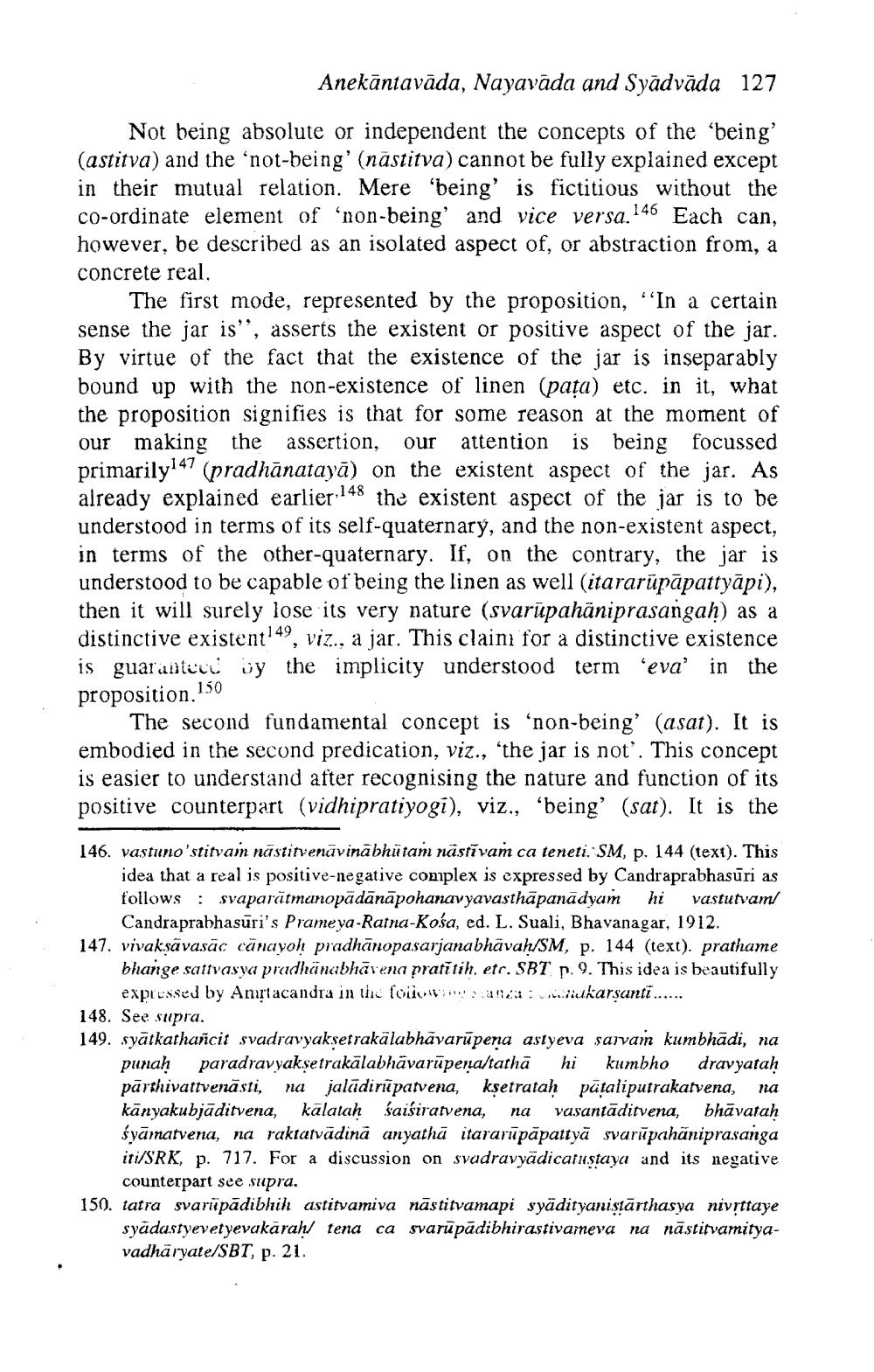________________
Anekāntavāda, Nayavāda and Syādväda 127
Not being absolute or independent the concepts of the 'being' (astitva) and the ‘not-being' (năstitva) cannot be fully explained except in their mutual relation. Mere 'being' is fictitious without the co-ordinate element of 'non-being' and vice versa.146 Each can, however, be described as an isolated aspect of, or abstraction from, a concrete real,
The first mode, represented by the proposition, “In a certain sense the jar is”, asserts the existent or positive aspect of the jar. By virtue of the fact that the existence of the jar is inseparably bound up with the non-existence of linen (pața) etc. in it, what the proposition signifies is that for some reason at the moment of our making the assertion, our attention is being focussed primarily147 (pradhānatayā) on the existent aspect of the jar. As already explained earlier:148 the existent aspect of the jar is to be understood in terms of its self-quaternary, and the non-existent aspect, in terms of the other-quaternary. If, on the contrary, the jar is understood to be capable of being the linen as well (itararūpāpattyāpi), then it will surely lose its very nature (svarūpahāniprasangah) as a distinctive existent 49, viz., a jar. This claim for a distinctive existence is guaranteru uy the implicity understood term 'eva' in the
proposition. 150
The second fundamental concept is ‘non-being' (asat). It is embodied in the second predication, viz., the jar is not'. This concept is easier to understand after recognising the nature and function of its positive counterpart (vidhipratiyogi), viz., 'being' (sat). It is the
146. vastuno'stitvam nästitvenāvinābhūtam nastīvam ca teneti SM, p. 144 (text). This
idea that a real is positive-negative complex is expressed by Candraprabhasūri as follows : svaparātmunopädānāpohanavyavasthāpanādyam hi vastutvam/
Candraprabhasūri's Prameya-Ratna-Kośa, ed. L. Suali, Bhavanagar, 1912. 147. vivaksāvasāc canayoh pradhānopasarjanabhāvah/SM, p. 144 (text). prathame
bhange sattvasya pradhanabhävena pratitih, etc. SBT p. 9. This idea is beautifully
expressed by Amrtacandra in the fount a nea ukarsanti ...... 148. See supra. 149. syātkathancit svadravyaksetrakālabhāvarūpena astyeva saivam kumbhādi, na
punaḥ paradravyak setrakālabhāvarūpena/tathā hi kumbho dravyatah pārthivattvenāsti, na jaladirāpatvena, kşetratah pataliputrakatvena, na kānyakubjāditvena, kālatah saisiratvena, na vasantāditvena, bhāvatah śyāmatvena, na raktatvādinā anyathā itararūpāpattyā svarūpahāniprasanga iti/SRK, p. 717. For a discussion on svadravyādicatustaya and its negative
counterpart see supra. 150. iatra svarupādibhih astitvamiva nāstitvamapi syādityanistārthasya nivrttaye
syādastyevetyevakārah/ tena ca svarūpādibhirastivameva na nāstitvamityavadhāryate/SBT, p. 21.




